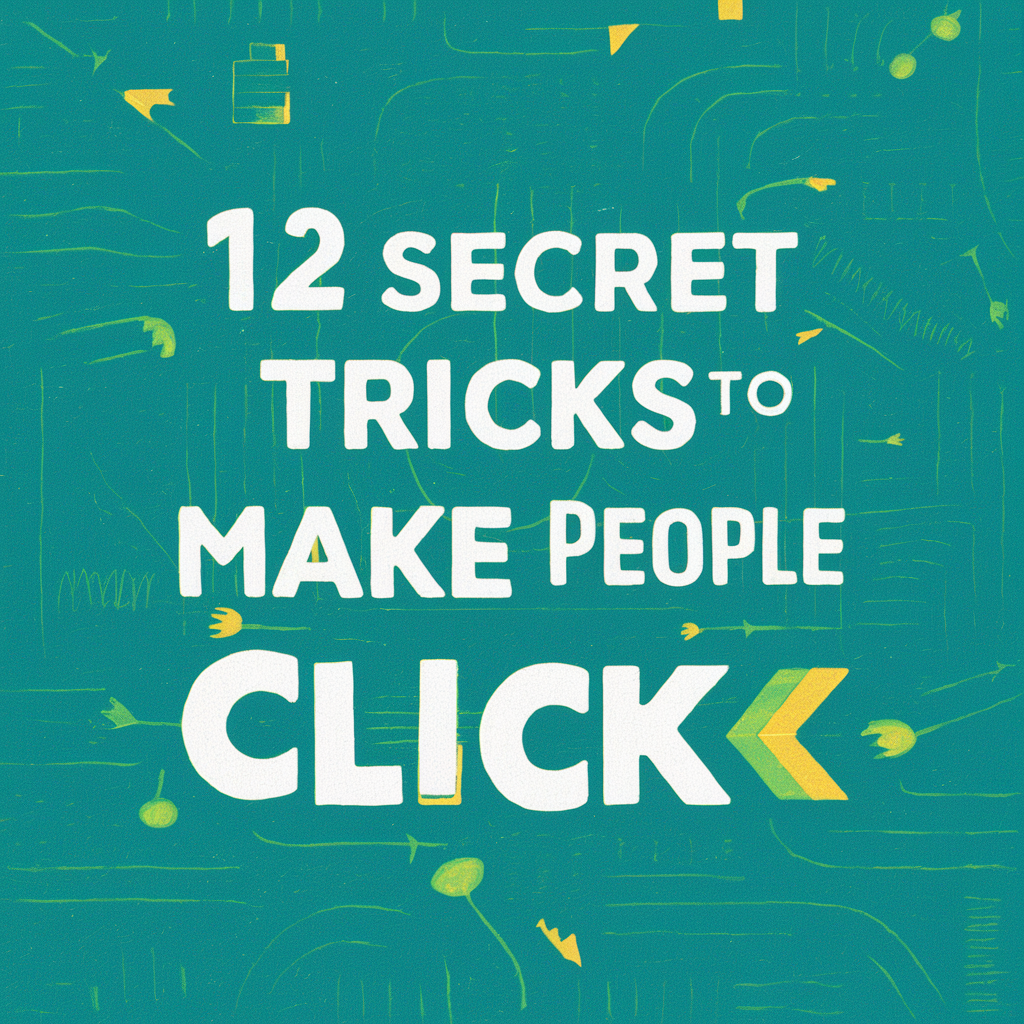In the fast-paced digital world, capturing attention is more challenging than ever. With countless pieces of content vying for your audience’s attention, having a click-worthy headline is crucial. A compelling headline not only grabs attention but also entices readers to engage with your content. Mastering the art of crafting these headlines can significantly boost your click-through rates and overall engagement.
Click-worthy headlines employ various psychological triggers and marketing strategies to persuade readers to click. From creating a sense of urgency to leveraging social proof, these techniques are designed to tap into the readers’ interests and emotions. Understanding and implementing these strategies can transform your content marketing efforts.
In this article, we’ll explore 12 powerful techniques to create headlines that make people click. By the end, you’ll have a toolkit of strategies to craft irresistible headlines that stand out in the crowded digital landscape.
For a deeper understanding of how structured content impacts SEO and engagement, check out Why H Tags Matter: Boost Your Website’s SEO.

Exclusivity: “How The Top 1%…”
Exclusivity is a powerful tool in creating compelling headlines. People are naturally curious about what makes the top 1% different and often aspire to achieve similar success. By hinting at insider knowledge or exclusive strategies, you can entice readers to click and discover what sets the elite apart.
How to Use Exclusivity in Headlines
- Highlight Special Access: Use phrases like “exclusive access,” “members-only,” or “insider secrets” to make readers feel they are getting something special.
- Invoke Curiosity: Phrases like “what the top 1% know” or “how the top 1% achieve success” play on the reader’s curiosity about elite strategies and secrets.
- Promise Valuable Insights: Ensure that the content delivers on the promise of the headline by providing unique or lesser-known information.
Example Headlines:
- “How The Top 1% Manage Their Time Efficiently”
- “Exclusive Tips From The Top 1%: Achieve Success Faster”
- “Insider Secrets: How The Top 1% Build Wealth”
By crafting headlines that offer exclusivity, you can create a sense of privilege and intrigue that drives clicks. For a practical example of providing unique, behind-the-scenes insights, see how Shopify Stores Aesthetics: Hide Descriptions with Simple CSS uses a simple yet effective strategy to enhance online store aesthetics.

Authority: “[Expert]’s Top Tips For…”
Leveraging authority in your headlines can significantly boost their effectiveness. People trust experts and are more likely to click on content that offers insights from a credible source. Using authority-driven headlines establishes trust and signals that the content is valuable and reliable.
How to Use Authority in Headlines
- Name-Drop Experts: Mentioning well-known experts or brands can lend credibility to your headline.
- Highlight Credentials: Use phrases that emphasize the expertise or credentials of the source, such as “doctor’s advice,” “top chef’s recipe,” or “financial guru’s strategy.”
- Promise Professional Insights: Ensure the content provides actionable advice or insights from the authority figure mentioned.
Example Headlines:
- “Dr. Smith’s Top Tips For Healthy Living”
- “Chef Gordon Ramsay’s Secrets To Perfect Pasta”
- “Warren Buffett’s Investment Strategies For Beginners”
Using authority-driven headlines can attract readers seeking credible and high-quality information. For example, check out Top 36 Rustic Vintage Fonts in Canva to see how expert recommendations can add value to content.
Contrast: “[X] Vs [Y]: Which One Is…?”
Using contrast in your headlines can pique curiosity and drive engagement by presenting a choice or comparison. People are naturally drawn to comparisons as they help in making informed decisions. Highlighting differences or evaluating two options can compel readers to click and find out which is better or more suitable for their needs.
How to Use Contrast in Headlines
- Present Two Options: Clearly state the two items or ideas being compared.
- Highlight Key Differences: Use phrases that indicate a comparison or evaluation, such as “versus,” “compared,” or “battle.”
- Promise a Conclusion: Suggest that the content will provide a definitive answer or recommendation.
Example Headlines:
- “Mac vs. PC: Which One Is Better For You?”
- “Organic vs. Non-Organic: Which Is Healthier?”
- “Freelance vs. Full-Time: Which Career Path Should You Choose?”
By framing your headlines around contrast, you can engage readers who are looking to make decisions or learn about the differences between two options. For instance, take a look at Thoughtful Mother’s Day Gift Ideas for 2024 to see how presenting varied gift ideas can attract diverse readership.
Efficiency: “How To [Big Task] In [Short Time]”
Efficiency-driven headlines promise to deliver quick solutions to big tasks, making them incredibly appealing to readers who are short on time but eager for results. Highlighting efficiency not only draws clicks but also positions your content as practical and valuable.
How to Use Efficiency in Headlines
- Specify the Task: Clearly define the big task or problem that your content will address.
- Highlight Time-Saving: Use phrases like “in minutes,” “quickly,” or “fast” to emphasize the efficiency of the solution.
- Promise Practical Solutions: Ensure that the content delivers actionable and easy-to-follow advice.
Example Headlines:
- “How To Organize Your Entire Home In One Weekend”
- “How To Boost Your Productivity In Just 10 Minutes A Day”
- “How To Create Stunning Graphics In 5 Easy Steps”
Using efficiency-driven headlines can attract readers looking for quick, actionable tips. For a practical example, check out Turning OBJ File Into G-Codes: Cura Makes This Easy, which demonstrates how to perform a complex task efficiently.
Social Proof: “Find Out Why 10K People Are…”
Social proof is a powerful psychological trigger that leverages the behavior of others to encourage action. By showing that many people are already engaged with your content or product, you can build trust and credibility, making others more likely to follow suit.
How to Use Social Proof in Headlines
- Highlight Numbers: Use specific numbers to show how many people are engaging with your content or product.
- Emphasize Popularity: Phrases like “10K people,” “millions of users,” or “trending now” can create a sense of widespread approval.
- Promise a Shared Experience: Suggest that readers will join a large group of people by clicking on your content.
Example Headlines:
- “Find Out Why 10K People Are Switching to This Diet”
- “Join the Millions Who Love This Fitness App”
- “Discover Why Thousands Are Raving About This New Skincare Line”
Using social proof can make your content more appealing by tapping into the natural human tendency to follow the crowd. For instance, see how Is Your Phone Watching You? The Terrifying Reality of Mobile Surveillance Exposed uses widespread concern to attract readers.
Urgency: “Last Chance To…”
Creating a sense of urgency in your headlines can prompt readers to take immediate action. Urgency leverages the fear of missing out (FOMO), compelling people to click now rather than later. This technique is particularly effective for time-sensitive offers or events.
How to Use Urgency in Headlines
- Highlight Time-Sensitivity: Use phrases like “last chance,” “limited time,” or “ending soon” to create a sense of urgency.
- Emphasize Consequences: Suggest what readers might miss out on if they don’t act quickly.
- Provide Clear Actions: Make it clear what the reader needs to do to avoid missing out.
Example Headlines:
- “Last Chance To Get 50% Off Your Favorite Items”
- “Limited Time Offer: Sign Up Before It’s Too Late”
- “Hurry! Sale Ends Tonight”
Using urgency-driven headlines can effectively drive immediate clicks and conversions. For a timely and impactful read, check out The Tech Habit That’s Wrecking Your Sleep: Break Free From Insomnia, which emphasizes the urgent need to address sleep issues.
Consistency: “You [Believe in X], Why Not [Y]?”
Leveraging the principle of consistency in your headlines can align with your audience’s existing beliefs or behaviors, making them more likely to click. This technique works by building on what readers already accept or practice, and then introducing a related idea or action.
How to Use Consistency in Headlines
- Identify Shared Beliefs: Start with a statement that reflects a common belief or value held by your audience.
- Introduce a Related Action: Connect the belief to a new, logical action or idea.
- Make the Connection Clear: Ensure that the relationship between the belief and the action is easy to understand and compelling.
Example Headlines:
- “You Care About Your Health, Why Not Try This New Superfood?”
- “You’re Passionate About Fitness, Why Not Explore Yoga?”
- “You Believe in Eco-Friendly Living, Why Not Switch to Solar Energy?”
Using consistency-driven headlines can resonate deeply with your audience, making them more inclined to engage with your content. For a relevant read on how consistency can enhance your website’s SEO, check out Why H Tags Matter: Boost Your Website’s SEO, which explains the importance of maintaining a structured and consistent approach.
Validation: “Key Signs You Might Be [X]…”
Validation-driven headlines resonate with readers by addressing their personal concerns or experiences. By identifying key signs or symptoms that your audience might be experiencing, you can create a sense of connection and relevance that encourages them to click.
How to Use Validation in Headlines
- Identify Common Concerns: Focus on issues that your audience is likely to be worried about or interested in.
- List Key Signs or Symptoms: Use phrases like “key signs,” “symptoms of,” or “ways to know” to directly address these concerns.
- Offer Solutions or Insights: Promise valuable information that will help the reader understand or address the issue.
Example Headlines:
- “Key Signs You Might Be Overtraining in the Gym”
- “Symptoms of Burnout: Are You Experiencing These?”
- “Ways to Know If Your Diet Is Actually Healthy”
Using validation-driven headlines can make your content feel more personal and relevant to your readers. For a deeper dive into addressing personal concerns, check out Is Your Phone Watching You? The Terrifying Reality of Mobile Surveillance Exposed, which validates common fears about privacy and surveillance.
Aspiration: “She Went From X To Y In…”
Aspirational headlines inspire and motivate readers by showcasing remarkable transformations or achievements. These headlines tap into the desire for self-improvement and the belief that similar success is attainable.
How to Use Aspiration in Headlines
- Highlight Transformations: Showcase a significant change or achievement, such as weight loss, career success, or personal growth.
- Use Real Examples: Mention real people or relatable scenarios to make the transformation more credible and inspiring.
- Promise Achievable Results: Suggest that the reader can achieve similar success by following the content’s advice.
Example Headlines:
- “She Went From Broke to Millionaire in Just Five Years”
- “He Lost 50 Pounds in Six Months: Here’s How”
- “From Struggling Artist to Gallery Owner: Her Inspiring Journey”
Using aspirational headlines can attract readers looking for motivation and guidance. For an example of content that inspires and provides practical advice, explore Thoughtful Mother’s Day Gift Ideas for 2024, which offers creative and meaningful suggestions.
Trust: “I [Specify Credentials] – Here’s Why…”
Building trust through your headlines can significantly enhance your content’s credibility. By highlighting your credentials or expertise, you reassure readers that the information they’re about to receive is reliable and authoritative.
How to Use Trust in Headlines
- Specify Credentials: Mention your qualifications, experience, or any notable achievements that establish your authority on the subject.
- Highlight Expertise: Use phrases like “as a doctor,” “with 20 years of experience,” or “award-winning” to emphasize your expertise.
- Promise Reliable Information: Ensure the content delivers valuable and accurate insights that align with the trust established in the headline.
Example Headlines:
- “I’m a Doctor – Here’s Why You Should Drink More Water”
- “As a Financial Advisor, These Are My Top Investment Tips”
- “With 20 Years of Experience, Here’s How I Manage Stress”
Using trust-driven headlines can attract readers seeking dependable advice. For instance, check out Top 36 Rustic Vintage Fonts in Canva to see how expert recommendations can enhance content credibility.
Commitment: “Start Your [X] Journey With…”
Commitment-driven headlines encourage readers to embark on a journey or start a new endeavor. By inviting them to begin a process or transformation, you create a sense of inclusion and long-term engagement.
How to Use Commitment in Headlines
- Invite Participation: Use phrases like “start your journey,” “join the movement,” or “begin your transformation” to encourage readers to take the first step.
- Highlight Benefits: Clearly state the positive outcomes or benefits of starting the journey.
- Create a Sense of Progress: Suggest that the reader will be part of a continuous process that leads to improvement or success.
Example Headlines:
- “Start Your Fitness Journey With These Simple Steps”
- “Begin Your Financial Independence Journey Today”
- “Join the Movement: Start Your Zero-Waste Journey Now”
Using commitment-driven headlines can attract readers who are ready to make a change or start something new. For example, see how Turning OBJ File Into G-Codes: Cura Makes This Easy invites readers to begin a journey into 3D printing.
FOMO: “This Genius [X] Trick Went Viral On…”
Leveraging the Fear of Missing Out (FOMO) in your headlines can be a powerful way to drive clicks. By highlighting trending or viral content, you create a sense of urgency and excitement that compels readers to see what they might be missing.
How to Use FOMO in Headlines
- Highlight Virality: Use phrases like “went viral,” “trending now,” or “everyone is talking about” to emphasize the widespread attention the content is receiving.
- Create Urgency: Suggest that the content is popular and timely, making readers feel they need to click immediately to stay in the loop.
- Promise Value: Ensure the content delivers valuable insights or tips that justify the hype.
Example Headlines:
- “This Genius Cleaning Hack Went Viral on TikTok”
- “The Recipe Everyone Is Talking About: Try It Now”
- “This Simple Productivity Trick Is Trending—Here’s Why”
Using FOMO-driven headlines can effectively attract readers who don’t want to be left out of the latest trends. For an example of content that taps into widespread concerns and trends, check out The Tech Habit That’s Wrecking Your Sleep: Break Free From Insomnia, which discusses a prevalent issue impacting many people today.
Mastering the Art of Clickbait
Creating compelling headlines that drive clicks is both an art and a science. By understanding and implementing these 12 powerful techniques, you can craft headlines that not only attract attention but also encourage engagement. Whether you’re leveraging exclusivity, authority, contrast, or any of the other strategies, the key is to resonate with your audience’s interests and emotions.
Recap of the 12 Techniques:
- Exclusivity: Make readers feel special by offering insider knowledge.
- Authority: Build trust by highlighting expert opinions and credentials.
- Contrast: Use comparisons to pique curiosity and highlight choices.
- Efficiency: Promise quick solutions to significant problems.
- Social Proof: Leverage the behavior of others to build credibility.
- Urgency: Create a sense of immediacy to prompt action.
- Consistency: Align with readers’ existing beliefs and behaviors.
- Validation: Address personal concerns and offer relevant insights.
- Aspiration: Inspire with stories of remarkable transformations.
- Trust: Build credibility by showcasing your expertise.
- Commitment: Encourage readers to start a new journey.
- FOMO: Tap into the fear of missing out to drive engagement.
By mastering these techniques, you can significantly boost your content’s click-through rates and overall engagement. Remember, the most effective headlines are those that deliver on their promises and provide genuine value to your readers.
For additional strategies on crafting engaging and optimized content, explore Why H Tags Matter: Boost Your Website’s SEO and Top 36 Rustic Vintage Fonts in Canva.
As an Amazon Associate we earn from qualifying purchases through some links in our articles.
